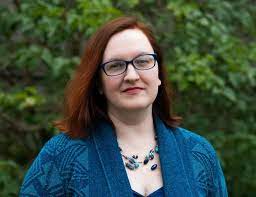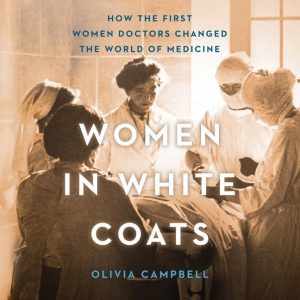My Journey into the World of Victorian Women Doctors By Olivia Campbell
My Journey into the World of Victorian Women Doctors
By Olivia Campbell
 Today, when a young woman announces her intention to become a doctor, she is greeted with cheers and praise. In the 1800s, such an announcement might plunge family members into depressive episodes and may even see the young woman disowned. Women interested in the grotesque practice of medicine were seen as deranged.
Today, when a young woman announces her intention to become a doctor, she is greeted with cheers and praise. In the 1800s, such an announcement might plunge family members into depressive episodes and may even see the young woman disowned. Women interested in the grotesque practice of medicine were seen as deranged.
This is just one of the many outrageous things I learned while researching my book, “Women in White Coats: How the First Women Doctors Changed the World of Medicine.” It’s about three of the first women to earn medical degrees: Elizabeth Blackwell, the first woman MD in America, Elizabeth Garrett-Anderson, the first woman MD in England, and Sophia Jex-Blake, the first woman MD in Scotland. Despite experiencing terrible sexism along the way, they chose not only to continue pursuing their goals, but to ensure those who came after them could do the same. They became unlikely friends who banded together to establish a women’s medical school in London. Their work proved pivotal in opening the medical profession to women and elevating the quality of women’s healthcare.
I got the idea for this book after reading about two riots, one in Philadelphia and one in Edinburgh. Both were cases of male medical students throwing violent temper tantrums when women dared to join them in the classroom. In 1869, male students at the Philadelphia Hospital hurled spitballs, tobacco juice, insults, and obscenities at the students from Woman’s Medical College of Pennsylvania who came to attend a lecture. A year later in Edinburgh, Scotland, a mob of hundreds threw mud, rotten eggs, and trash at the women students who were on their way to take an exam.
I wanted to dig further into what Victorian women endured while attempting to enter the field of medicine and what drove them to keep going without support or encouragement.
Many of the women who made the decision to go against tradition and become doctors were driven by witnessing female friends or relatives suffering through illnesses or dying slow, agonizing deaths because they didn’t want to consult a male doctor or they felt they couldn’t tell these doctors about all of their troubles. They also wanted to widen the professional and educational opportunities available to women beyond teaching.
Women have been practicing medicine throughout history across cultures around the world. But patriarchal control swept in during the middle ages as medicine was transformed into a profession that required university education and licensure. Lay healers were vilified as witches and burned at the stake. Women were viewed as weak imitations of men, unfit for higher education because it was too taxing on their minds — they would use their energy on their brain instead of their uterus and they would be left sterile. Society maintained that a woman’s place was in the home.
My original proposal included many more early medical women, but I chose to focus on these three because I wanted to tell the intriguing story of how they came together to open the first medical school for women in the UK. Their personalities were so different and they had a lot of disagreements, so it makes for a lively, compelling tale. Each woman had such a different character: Blackwell, the eccentric, ascetic single mother to an adopted daughter; Garrett-Anderson, the stubborn, yet demure lady who married and had three kids (even performing surgery while pregnant!); and my favorite, Jex-Blake, the opinionated, determined lesbian with a bad temper and a brilliant mind.
It took me a year and several rounds of edits from my agent to craft a polished proposal because I had to keep freelancing. My agent had reached out to me after reading one of my essays and asked if I had any book ideas. (I actually had several agents reach out in response to that essay.) I didn’t have any ideas ready to go, but I quickly made a short list of potential nonfiction book ideas. My agent helped me pick the winner by asking me to choose the topic I could spend a few years getting lost in without getting bored of it.
The first submission round received universal feedback: great idea, narrow the focus. After cutting out the sections on the Woman’s Medical School of Pennsylvania and focusing solely on the story of the founding of the London School of Medicine for Women, I had a winner: several major publishers showed interest. I sold it to Park Row Books, a HarperCollins imprint, and have had an incredible experience with the team there. My book advance funded research trips to New York, London, and Edinburgh, where I got to dig through archives and read letters and journals penned by the women I was writing about.
By bringing women back into the profession, these women changed the field of medicine. They questioned the dubious claims of male doctors about how women’s bodies worked, and investigated the real culprits they suspected were at the root of most women’s illnesses: frequent pregnancies, heavy, restrictive clothing, unsafe working conditions in factories and domestic service, and sexist social norms encouraging men, but not women, to exercise their bodies and minds. They helped popularize preventative medicine, home healthcare, social workers, and antiseptic practices. Most of all, they proved to the world that women could be doctors and surgeons. And great ones, at that.
—
Olivia Campbell started writing as a young girl – mysteries fashioned after her beloved Nancy Drew. As a teen, her passion for ballet saw her train to become a professional dancer. A broken foot prompted Campbell’s pivot to arts journalism. In college, an unplanned pregnancy, complicated birth, and postpartum depression turned her writing interest from the arts to medicine.
Now, she is an independent journalist, essayist, and author focusing on the intersections of medicine, women, history, and nature. Her work has appeared in The Atlantic, New York Magazine/The Cut, HISTORY, The Washington Post, The Guardian, SELF, Aeon, Scientific American, Smithsonian Magazine, Literary Hub, Atlas Obscura, Good Housekeeping, Catapult, Parents, and Undark, among others. (See Portfolio.)
Her first book, the nonfiction title WOMEN IN WHITE COATS: HOW THE FIRST WOMEN DOCTORS CHANGED THE WORLD OF MEDICINE, was published in March 2021 by HarperCollins/Park Row Books.
Campbell holds a master’s degree in nonfiction science writing from Johns Hopkins University and an undergraduate degree in journalism from Virginia Commonwealth University. She is a member of the National Association of Science Writers. Campbell lives in the Philadelphia suburbs along with her husband, three sons, and two beloved cats.
 Find out more about her on her website https://www.ocampbellwriter.com/
Find out more about her on her website https://www.ocampbellwriter.com/
Follow her on Twitter https://twitter.com/liviecampbell
WOMEN IN WHITE COATS: HOW THE FIRST WOMEN DOCTORS CHANGED THE WORLD OF MEDICINE
For fans of Hidden Figures and Radium Girls comes the remarkable story of three Victorian women who broke down barriers in the medical field to become the first women doctors, revolutionizing the way women receive health care.
In the early 1800s, women were dying in large numbers from treatable diseases because they avoided receiving medical care. Examinations performed by male doctors were often demeaning and even painful. In addition, women faced stigma from illness—a diagnosis could greatly limit their ability to find husbands, jobs or be received in polite society.
Motivated by personal loss and frustration over inadequate medical care, Elizabeth Blackwell, Elizabeth Garrett Anderson and Sophia Jex-Blake fought for a woman’s place in the male-dominated medical field. For the first time ever, Women in White Coats tells the complete history of these three pioneering women who, despite countless obstacles, earned medical degrees and paved the way for other women to do the same. Though very different in personality and circumstance, together these women built women-run hospitals and teaching colleges—creating for the first time medical care for women by women.
With gripping storytelling based on extensive research and access to archival documents, Women in White Coats tells the courageous history these women made by becoming doctors, detailing the boundaries they broke of gender and science to reshape how we receive medical care today.
BUY HERE
Category: Contemporary Women Writers, How To and Tips
























Sounds like a great book. I’m going to put it on my wish list. Thanks for putting in the hard work.
Thanks for this! I write fiction (as opposed to non-fiction) but my Victorian novels are about women in 1870s London who work toward autonomy and self-authorization in the fields of music and art (as opposed to medicine). Often when I give author talks, people will ask, “But could a woman really study piano at the Royal Academy? Could she really study at an art school?” Yes, in the 1870s real Victorian women were doing these things, but the women were, admittedly, outliers. I’m always interested in Victorian women pushing up against boundaries and norms. I’ll check out your book!